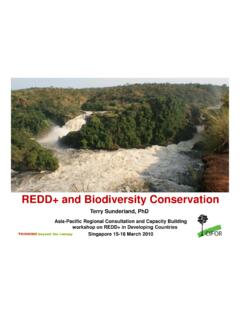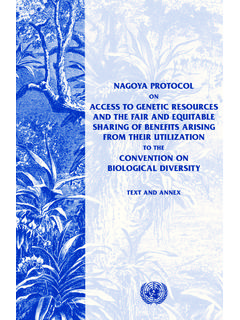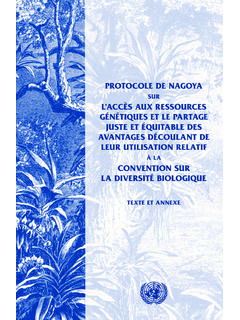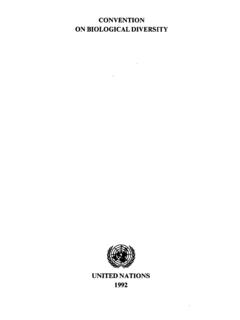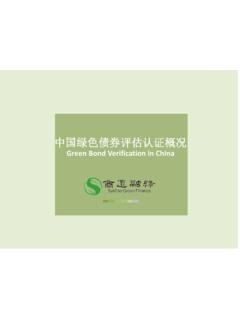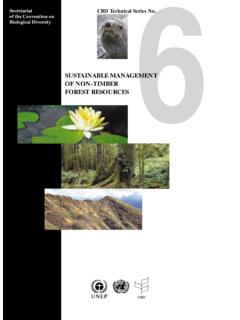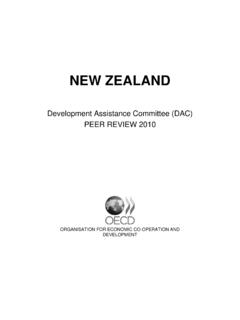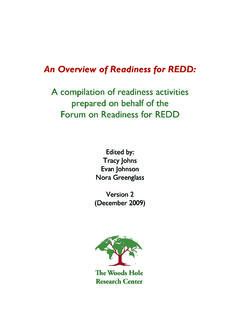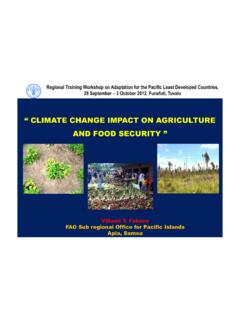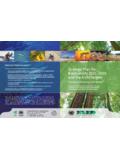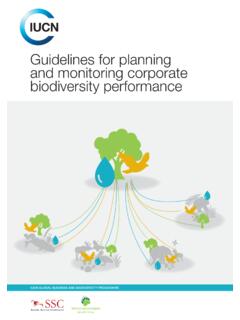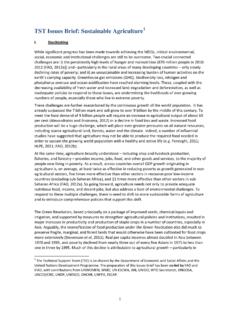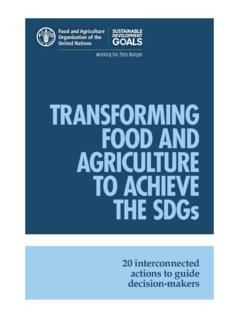Transcription of Water and Biodiversity - Convention on Biological Diversity
1 Water and BiodiversitySummary of the findings of the Fourth Edition of the Global Biodiversity Outlook as they relate to Water Secretariat of the Convention on Biological information in this publication draws heavily from the fourth edition of the Global Biodiversity Outlook (GBO-4) and its underlying reports, including CBD Technical Series 79 ( ). It is also based on the CBD publication Natural Solutions for Water Security ( ). For acknowledgements and references please see these designations employed and the presentation of material in Global Biodiversity Outlook 4 do not imply the expression of any opinion whatsoever on the part of the Secretariat of the Convention on Biological Diversity concerning the legal status of any country, territory, city or area or of its authorities, or concerning the delimitation of its frontiers or :Secretariat of the Convention on Biological Diversity (2015) Water and Biodiversity .
2 Summary of the findings of (GBO4) and implications for action as they relate to al, 9 further information, please contact:Secretariat of the Convention on Biological DiversityWorld Trade Centre413 St. Jacques Street, Suite 800 Montreal, Quebec, Canada H2Y 1N9 Phone: 1 (514) 288 2220 Fax: 1 (514) 288 6588E-mail: photographs used under license of and Biodiversity 1 IntroductionThe links between the Water sector1 and biodi-versity involve both the impacts of the sector on Biodiversity and the benefits the sector can receive from the ecosystem services provided by Biodiversity .
3 The Water sector therefore should have a direct interest in safeguarding biodiver-sity both for its own use and for that of others. The Fourth Edition of the Global Biodiversity Outlook (GBO-4) undertook a mid-term review of progress towards the implementa-tion of the internationally agreed Strategic Plan for Biodiversity 2011 2020 and its 20 Aichi Biodiversity Targets. This document presents a summary of the main findings from this report as relevant to the Water sector. It is structured around the following key questions: How does Biodiversity benefit the Water sector? What is the current status of Biodiversity ?
4 What do long-term scenarios for Biodiversity tell us about Water issues in the future? What needs to be done?How does Biodiversity benefit the Water sector? Water is an ecosystem service. Well-functioning ecosystems forests, grasslands, soils, rivers, lakes, streams, wetlands, aquifers, estuaries and coastal waters provide services that influence the availability of Water and its quality. These services are also vital to meet Water management goals such as Water storage and flow regulation, filtering and flood and drought protection, among others. These ecosystem services are impacted by Water and land management decisions and in turn influence Water availability and quality.
5 In addition Biodiversity is directly implicated in maintaining most ecosystem functions that deliver these services but it is also a co-benefi-ciary of improved ecosystem conditions. Some specific objectives of Water management that ecosystems and Biodiversity can assist in achieving are:Urban Water management - Protecting biodi-versity, natural vegetation and other ecosystem attributes in catchment areas is part of proper land-use management. Intact ecosystems prevent the pollution of Water sources, reduce erosion and prevent floods thus helping to deliver cleaner Water more reliably.
6 Natural, restored and constructed ecosystems within cities can provide _____1 Here the Water sector is understood in its broadest context and includes not only those stakeholders in the Water supply, treatment and sanitation sectors, but also all relevant stakeholders involved in policies, management and actions that influence, or depend on, the availability and the quality of Water . This includes issues relevant to industry, agriculture, forestry, tourism, environment, education and investment among and Biodiversity2 The Strategic Plan for Biodiversity 2011-2020 was adopted by the Conference of the Parties to the Convention on Biological Diversity in 2010.
7 This plan provides an overarching framework on Biodiversity , not only for the Biodiversity -related conventions, but for the entire United Nations system and all other partners engaged in Biodiversity management and policy development. It is comprised of a shared vision, a mission, strategic goals and 20 ambitious yet achievable targets, collectively known as the Aichi Biodiversity Targets. The Strategic Plan serves as a flexible framework for the establishment of national and regional targets and it promotes the coherent and effective implementation of the three objectives of the Convention on Biological Diversity .
8 Strategic goal aAddress the underlying causes of Biodiversity loss by mainstreaming Biodiversity across government and societystrategic goal bReduce the direct pressures on Biodiversity and promote sustainable usestrategic goal cImprove the status of Biodiversity by safeguarding ecosystems , species and genetic diversitystrategic goal dEnhance the benefits to all from Biodiversity and ecosystem servicesstrategic goal e Enhance implementation through participatory planning, knowledge management and capacity buildingimplementation support mechanismsmissionTake effective and urgent action to halt the loss of 2050, Biodiversity is valued, conserved, restored and wisely used, maintaining ecosystem services , sustaining a healthy planet and delivering benefits essential for all diagram shows the structure of the Strategic Plan for Biodiversity 2011 2020.
9 Progress towards a 2050 Vision is achieved through a 2020 Mission. In turn, the Mission is addressed through five Strategic Goals under which the 20 Aichi Biodiversity Targets are organized, and supported by implementation mechanisms. The Strategic Plan serves as a flexible framework for the establishment of national and regional targets and it promotes the coherent and effective implementation of the three objectives of the Convention on Biological more information about the Strategic Plan for Biological Diversity 2011-2020, please and Biodiversity 3natural infrastructure to support sustainable urban Water drainage and Water management - Intact flood-plains contribute to the regulation of seasonal Water flows, securing Water availability and quality for agriculture and industry.
10 Buffer strips along Water bodies are often used to reduce the run-off of nutrients, chemicals and sediments from farming, helping to improve Water quality. Vegetation in the landscape supports local climates, including rainfall and groundwater infiltration, and Water security for farming and livestock. Water management for dams and hydropower- The management of vegetation and soils in catchments to prevent erosion and reduce sediment loads in reservoirs has long been good practice. Increasingly, ecosystem restora-tion is being used to significantly improve dam efficiency and life-expectancy.
